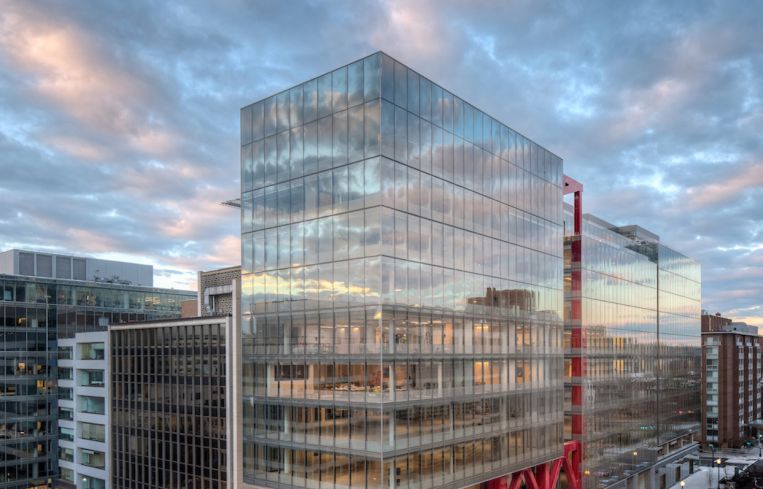Owners, Cities Lean Into LEED Amid Office Market Downturn
Buildings can command rent premiums above uncertified towers
By Keith Loria January 9, 2023 1:43 pm
reprints
In 2017, the U.S. Green Building Council named Washington, D.C., the first LEED Platinum city in the United States.
LEED — short for Leadership in Energy and Environmental Design — is a green-building certification and rating program that gauges buildings’ energy efficiency, carbon reduction, sustainability and other qualities.
Now, five years later, an above-average share of D.C. office buildings — 44 percent — are LEED certified, according to the U.S. Green Building Council. That ranks the city No. 6 in the U.S.
“D.C.’s LEED Platinum certification recognizes the outcomes, rather than intent, of the city’s leadership in creating a sustainable and resilient built environment, which includes reducing greenhouse gas emissions, supporting clean energy innovation, and focusing on inclusive prosperity and livability in all eight wards,” according to a statement.
Minneapolis ranks first with 53 percent of its office buildings LEED Platinum certified. The top five cities also include San Francisco (49 percent), Chicago (48 percent), Oakland (46 percent) and Portland, Ore. (44 percent). Rounding out the top 10 are Seattle (41 percent), Charlotte (36 percent), Miami (36 percent) and Manhattan (34 percent).
LEED-certified office buildings command a premium over their uncertified peers — all the more important post-pandemic, according to a new report from CBRE.
“LEED certification certainly is viewed as favorable by office occupiers, many of whom increasingly are requiring building owners to explain their ESG platforms during the space-search process,” Mike Watts, CBRE’s president of Americas investor leasing, said in a statement. “A LEED certification may turn out to be a key determinant in a given occupier’s decision of where to lease their space, regardless of whether that designation brings a rent premium.”
LEED certifications commanded an average rent premium of 4 percent between 2019 and 2022 over non-certified developments, per a CBRE analysis.
“LEED-certified buildings tend to be in better locations, are newer and have undergone major renovations,” Alex Wang, an economist with CBRE research, told Commercial Observer. “Naturally, these buildings are more attractive to tenants as they downsize and demand better space, a pre-pandemic trend that has been accelerated by the pandemic.”
Even after controlling for the age, location and renovation history of a building, a LEED-certified building can still demand higher rent — a signal that occupiers put monetary value on LEED certification, according to CBRE’s research.
The average 4 percent premium for LEED-certified buildings is on the lower side compared to a historical window of a 4 to 8 percent premium. Yet even in such challenging times for the U.S. office market, LEED certification creates value for buildings, per the statement.
“We anticipate the premium will increase a bit as the office market slowly recovers and office occupiers increasingly favor sustainable properties,” Wang said.
LEED-certified buildings command an average rent that is 6 percent above the overall average in D.C., as well as a lower vacancy rate—18.2 percent versus 20.5 percent for the overall market, according to Stephanie Jennings, CBRE’s mid-Atlantic research director.
“Rent in LEED-certified buildings averages $61.82 per square foot versus $58.17 per square foot for the overall market,” she said.
In 2010, the U.S. General Services Administration, which leases or owns hundreds of millions of square feet on behalf of the federal government, set a requirement for LEED Gold certification as a minimum in all new federal building construction, lease construction and substantial renovation projects. As such, GSA was an early adopter of LEED certification. As a result, many buildings looking to land GSA as a tenant pursued LEED certification.
“However, as other certifications came online, including Green Globes, GSA stopped requiring LEED certifications in the buildings they leased except in unique circumstances,” said Marcy Owens Test, executive vice president for CBRE and leader of the firm’s federal lessor advisory group. “Now, with the beginning of the current administration, this White House highly values sustainability in the real estate portfolio and we are beginning to see LEED certification as a more common — though not mandatory — requirement.”
Update: This story originally misattributed source material. This has been corrected. We apologize for the error.
Keith Loria can be reached at Kloria@commercialobserver.com.



